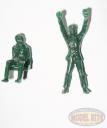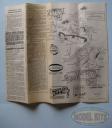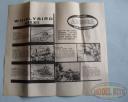By Fred Boucher and with Kit History by Alan Bussie
Kit History
Aurora’s Albatross D-3 [sic] was the fourth model of Aurora’s 20 “Famous Fighters” 1/48 World War One aircraft. It was released in 1956 with five other single-seaters. (Curiously, although Aurora released their “Sopwith Tripe” years later, it was originally numbered 100.)
The initial issue first appeared in Aurora’s 1956 Catalog and on dealer’s shelves the same year. The kit number was 104-69. Jim Cox did the box art and the instructions. 1956 was the first year for the large rectangular ‘Northern Lights’ logo.
First Issue Albatross D3, # 104-69
Aurora rolled out a new logo in 1957. But creating new box art was costly, so they simply modified the old art with the new oval ‘Famous Fighters’ logo with the northern lights on the inside background. The price went up ten cents, changing the part number to 104-79. The Parent’s Magazine seal was added at the left. This issue was probably produced from 1957 until around 1960.
Second Issue Albatross D3, # 104-79
Aurora updated the logo around 1959/60. In this ‘modernization’ the ‘Famous Fighters’ in the logo border was removed as well as the Parents Magazine seal. The part number remained the same as did the kit contents. This issue was probably made from about 1960 until around 1963. The exact dates are not known.
Third Issue Albatross D3, # 104-79
Aurora had a major update to the WWI line starting in about 1963. This is an assumed date simply because new WWI kits with new box art appeared in that year. The old box art was replaced by a fresh John Steel design as well as the new streamlined logo. This box is found dated “1956” but is in fact much later than that. This issue, #104-100, remained on sale until 1975.
Fourth Issue Albatross D3, #104-100
Albatross D-3 was not one of the models Aurora reworked in 1972 by adding fabric texture and removing raised insignia & data markings for subsidiary K&B’s excellent “Collectors Series.” However, Aurora did rework the fuselage to resemble the Albatros D.V and reissued it as kit number 752 in the 1976 700-series models. This kit is the first time that Aurora spelled “Albatros” correctly (in association with the D3 molds). The model included full rigging instructions, greatly improved wing assembly, pilot figure and decals for two colorful aircraft- Pilot-Lt. Paul Baumer (44 victories) or Jasta 5 ‘Green Tail’ (pilot unknown).
Subsequently, after Aurora went tango-uniform, their molds and tooling suffered different fates. Monogram bought the molds and tooling but lore holds that some were destroyed in a train wreck; a few of the WWI series were saved by Glencoe Models who re-issued them with several decal options. The Glencoe Albatross, however, looks nothing like the Aurora kit. It seems the Aurora Albatross D-3 survives only by 50-year-old copied mold by Merit, which eventually came under the possession of SMER.
Many Albatros D models have been kitted over the years in various scales and media, including a balsa D.V & D.Va in 1/3 scale! A quick spin around the net shows that Aurora’s original can be built into a beauty!
Flightline Walk-Around
Molding is high quality with no flash and virtually no mold seam lines. There are some visible ejector marks although they are not as obvious nor extensive as other Aurora “Famous Fighter” kits. I found a couple very minor sink marks. Tooling scale-thin struts and such were beyond Aurora’s ability (or interest). I dry-fit the fuselage halves- filler will be necessary although squashing the glued halves together may be enough to seal them. The fit between the fuselage and stabilizer is pretty impressive, as is the fit of the cabanes and interstruts.
(click any photo to enlarge)
(click any photo to enlarge)
The model was made with a slot under the fuselage for Aurora’s separately availible wall display bracket.
To populate the kit, a seated pilot and standing mechanic are provided with a ground base.
Detail
Aurora put enough effort into the crew that they are not lumps of humanoid plastic. However, the detail is soft and the mechanic’s hands look awfully big. Both figures are marred by ejector marks and the mechanic has a sink hole in the groin. Most of the kits flash and seam lines are on these crew figures.
Sadly, as was the fashion of the era, all insignia and data stenciling are molded onto the wings, fuselage and rudder in relief. Removing it is a horrible exercise at best even on flat surfaces! Otherwise the fuselage looks good. It features both raised and recessed detail. The engine cooling louvers are rounded and not open. The top sides of the wings have ribbing detail but the undersides do not. They do have the top wing underside mounting brackets for the cabanes. If it were not for the ejector marks and thick edges, the overall molding would rival third-generation kits.
(click any photo to enlarge)
Aside from the pilot, seat-floor, control stock and instrument panel with a dial and two switches, there is no interior detail. A tiny gun sight is included.
(click any photo to enlarge)
The wheels blend the tires to the hub covering.
The Mercedes D.III in-line engine is pretty impressive for the era. I like it so much I kept two or three after dispatching the airframe with fireworks!
(click any photo to enlarge)
Two 7.92mm Spandau LMG 08/15 machine guns are awful. Just lumps of plastic.
Accuracy
Aurora made the model too long at 30-feet 6-inches. Aurora was one of – if not the – first companies to mold continuous scale models instead of “box scale” kits. I did not place the plastic parts over accurate line art to check the model profile and planform. My impression is that it is off: the general profile is pudgier with the rounder fuselage of the Albatros D.V. Hey, it looks like an Albatros D.III – what references did they have back then?
Instructions, Painting And Decals
Aurora made no effort to even hint that an Albatros had rigging in the textual and exploded view instructions. They did advertise Aurora’s Polystyrene Cement and enamel paints. A history of the Albatros D.III is included. The back side is a catalogue of Aurora’s models.
(click any photo to enlarge)
There is no painting guidance other than Aurora directing the modeler to reference the box art!
The decals are sharply printed and opaque, although thick and slightly off register. The only identity of the model is serial Nr. D.1941/16; Ernst Udet few Albatros D.1941/16 in Jasta 15 but these markings don’t look like photographs of Udet’s Albatros. The fuselage band may or may not be authentic.
(click any photo to enlarge)
Conclusion
Aurora did a commendable job of molding and detail for the era. I appreciate the figures and display base also.
Visible ejector marks, token detail, and soft detail on the figures detract from the overall model.
Those who wish to build it to current standards will find it ripe for detailing and in need of serious surface sanding. No doubt you can make a respectable model with it, as evidenced by the many examples online.
HISTORY OF THE GERMAN ALBATROSS D-3 SCOUT (From the instructions with Aurora punctuation and spelling)
When the Albatross D-1 Scout Biplanes were first introduced towards the close of 1916, they quickly achieved a marked superiority over Allied planes such as had not been known since the days of 1915, when the Fokker monoplane was at its peak. On September 17th, Boelke, the German ace, led the first large formation of scouts organized on “circus” lines ever to cross into Allied territory and engaged eight British planes from the R.F.C. No. II Squadron. The obsolete British planes were completely outmoded by their heavier, more powerful opponents and none of them survived the onslaught. The Albatross D-1 was the first to use twin synchronized Spandau machine guns mounted above the motor cowling immediately in front of the pilot. After the advent of the Albatross, the twin synchronized guns became standardized on both Allied and German types.
The D-1 went through a number of changes, designed to improve its performance and in the spring of 1917 the Albatross D-3 made its appearance over the Western front and helped give “Bloody April” its name. The D-3 retained many of the characteristics of the earlier 1916 models but the large lower plane of the wing and the parallel interplane struts were abandoned in favor of a sesquiplane design with a narrow single spar lower wing and the famous “Vee” interplane strut and they were immediately dubbed “Vee-strutters” by the Allied pilots. A further modification to the wing design was the marked sweep-back on the ailerons of the upper wing.
For a short time the D-3 proved virtually invincible against the current Allied planes which enabled many German aces to build up their early scores. During “Bloody April” they were largely responsible for the destruction of 368 British planes and in the same month British hopes were dashed when a formation of the new Bristol fighters, led by Capt. Leefe-Robinson, was defeated by a group of D-3 Scouts. Baron von Richthofen, leading this “Vee-strutter” equipped Jagdstaffel II, gained a good deal of his prominence, counting among his victories, Major Lanoe Hawker, V. C., commander of the R.F.C.’s crack No. 24 Squadron, whom he shot down in a De Havilland DH-2 pusher.
Further improvements to the highly suc¬cessful D-3 resulted in the D.V., which came into service as a replacement for the earlier versions in the summer of 1917. The final blow to the Albatross reputation came in the autumn of 1917 when it was abandoned in favor of the radical Fokker Triplane by the foremost German Staffels.





















